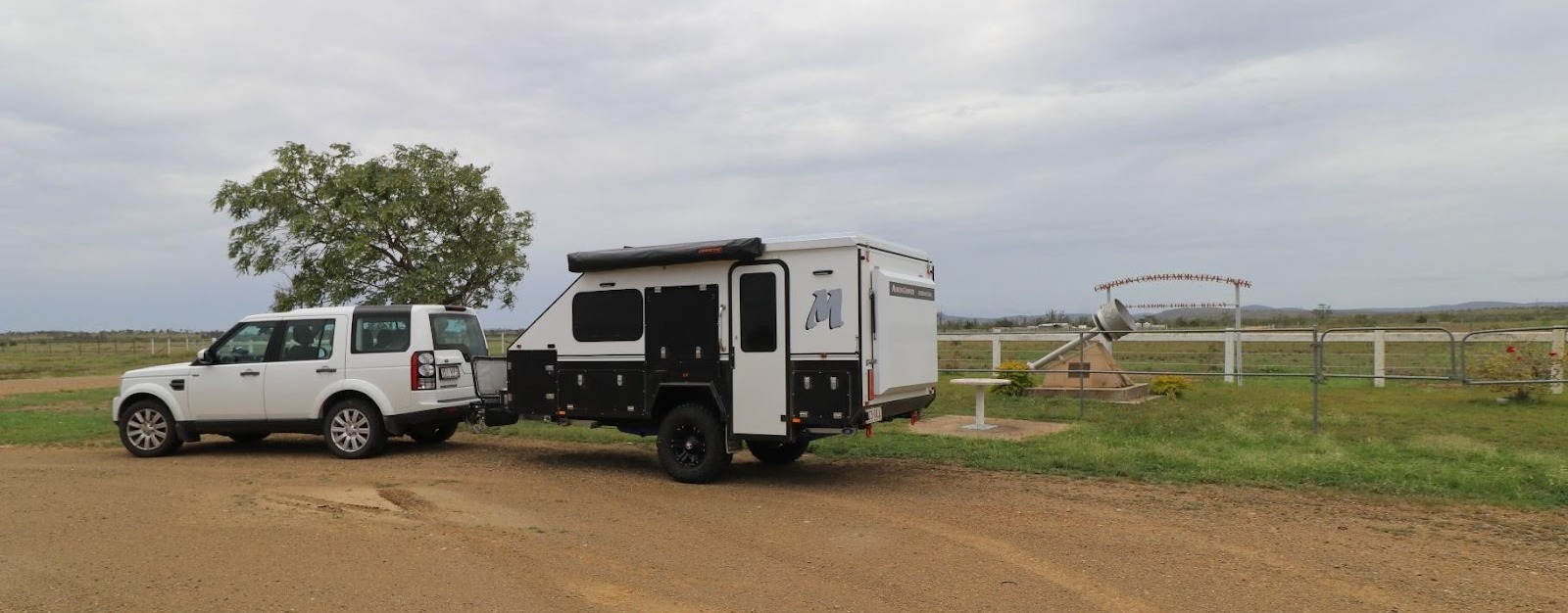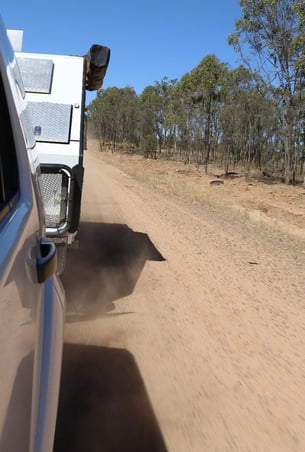Towing tips for your new hybrid camper

Setting out on your maiden camping trip in your new hybrid camper is so exciting. But it can also be pretty scary, especially if you haven’t towed before.
Looking back at my first towing experience. I was so nervous – sweaty hands and sleepless nights contemplating it! How do I turn corners? Will I be able to park it? How will the car handle it? And don’t even get me started on backing! But it wasn’t as bad as all that!
Here's a few things you need to know, and you'll be towing like a pro in no time!
Getting Ready
- Electric Brake Controller. – If your hybrid camper has electric brakes, your car will need an electric brake controller. I recommend the Redarc Tow-Pro Elite for ease of use.
- Vehicle Maintenance - Towing a camper can put a lot of strain on your vehicle. I like to think of vehicle maintenance as my insurance policy for a stress-free holiday. Before you head off check your vehicle’s brakes, coolant levels, oil levels and tyres. And while you’re at it don’t forget to thoroughly inspect your camper, see our Camper Safety Checklist below.
- Camper Width – You’ll need towing mirrors if your camper trailer is wider than your car.

Towing tip - Towing a camper wider than your vehicle can be very stressful and fatiguing, especially on narrow outback roads. They also have limited visibility down the sides of the camper requiring extended side mirrors for your car which limits your off-roadability Ideally you want a camper with a track width and body width as close to your car as possible. The added advantage of a hybrid camper is that you don't need those extended mirrors. Read more about camper width in our "Hybrid Camper vs Caravan" blog.
- Packing is a balancing act – Is one side of your camper heavier than the other? Having one side of your camper heavier than the other can make it unstable when towing. You’ll find most hybrid camper trailers have the kitchen, fridge and pantry fitted on the passenger side. If this is the case, try to pack heavier items to the driver’s side if possible. If your camper has two or more water tanks, they’ll most likely be mounted evenly either side of the axle. Either completely fill the tanks or try to fill the tanks to the same level so as to even out the load. Whatever you do, don’t give your hybrid camper a bulging but! Moving too much weight to the back of the camper can cause severe swaying, snaking, or rolling over. This is due to the pendulum effect which can best be explained in this video.
- Practice reversing your camper before you go - Reversing your hybrid camper for the first time in front of a crowded campsite can be very stressful. Instead, head out to an industrial estate or deserted shopping centre car park on a weekend to practice before you set out. Start by just getting used to backing in a straight line. Once you’ve got the hang of that use some boxes or witches’ hats and mark out a caravan site and practice backing into it. Make sure to practice this from both directions. The most important thing to remember when backing, is the Opposites Rule. To turn the camper to the right whilst reversing, you need to turn the steering wheel gradually to the left. To turn the camper left, turn the steering wheel to the right. If you oversteer in one direction or the camper begins to jack-knife, stop and move forward in a straight line until the camper has straightened up completely behind your vehicle.
- Check the hitch – ensure that your hybrid camper is connected properly and the hitch is latched. When attaching your safety chains make sure to cross the chains beneath the hitch and coupling with enough slack to allow turning and but tight enough to hold the hitch up off the ground should the trailer come loose. If your camper has an Aggregate Tare Mass (ATM) of over 2000kg, ensure the breakaway cable is properly adjusted and attached to your vehicle. Note, you may have unused links – don’t cut them off, if they’re dragging on the ground use a connecting chain link such as this to gather the extra links.
- Check the lights – Ensure the trailer plug is properly connected. Check the electric brakes are working – when you depress your brake pedal you will hear a clicking noise from the brakes on your camper. Check brake lights, turning signals and running lights are all working.
- Wheels Up – Stow the jockey wheel properly and check that both it and your stabiliser legs are securely locked in their travel position.
- Final Inspection – For peace of mind I always check the camper from front to back. Starting at the hitch on the passenger side, walk around the whole camper double-checking the hitch and chains; the jockey wheel and the stabiliser legs – give them a little jiggle to make sure they’re properly latched; the doors and windows are locked; the power has been turned off to all but the fridge and finally that the trailer plug is secure.
Camper Safety Checklist:
- Check tyre condition and pressure
- Wheel nuts are tightened to 110 foot pounds
- Suspension bolts are tightened to 190 foot pounds
- Stabiliser legs are raised and locked in place
- Coupling and safety chains are correctly fastened
- Electrical connection is secure and lights/stop light/indicator lights are working
- Hand brake is released
- Jockey wheel is secured
- Gas is turned off
- Internal lights are turned off
- Steps are properly stowed
- Slides, drawers and doors are secured
- All windows are closed and secured with the blinds in the open position
- External doors locked
- Check your mirrors are properly adjusted
- Final inspection
On the Road
Remember that the camper will affect the performance of your vehicle, whether you’re accelerating, braking or cornering. Slow down, take your time, enjoy the trip and stay safe. Here are some key towing tips to keep in mind:
- Allow longer distances for braking, remember you have an extra couple of tons to have to slow down!
- Avoid sudden lane changes, keep steering as smooth and gentle as you can.
- Take a break or change drivers every 2 hours, towing a camper can be very tiring as you need to be more alert to anticipate upcoming traffic, road conditions and hills.
- Be careful when overtaking, not only do you have to factor in the added length of your rig, but how the added drag of the camper will affect acceleration.
- Swing wider and later than normal when cornering, your camper will have a tighter turning circle than your car. Make sure your camper has enough room to get around the corner without “cutting in”.
- Be courteous to other drivers, if you’re travelling slower than other drivers, where safe, pull over to let traffic behind you overtake or flash your indicator to show when it is safe to overtake you.
- If you are leaving the road, be aware of the state of the edge of the road. Is there a pronounced edge? Are there any hazards ahead? Is the side of the road likely to be soft or slippery?
Several years ago, what should’ve been a simple pullover and re-entry for oncoming traffic nearly ended in tragedy. I had to re-enter the road more rapidly than I’d anticipated due to an upcoming culvert. The camper’s wheel got caught on the lip of the bitumen and the camper began to sway uncontrollably. Thankfully we got out of it pretty lightly. We ended up in a paddock with a little barbed wire tattoo down the side of the car, but no one was injured. Safe to say that’s an experience I don’t want to repeat.
- What if the camper starts to sway?
-
- Don’t panic! – I know that sounds impossible, and it’s hard to do, but a level head is your best bet.
- Quick or jerking steering movements will make the situation worse, try to steer as little as possible to correct the sway. Hold your position and try to go as straight as possible.
- Don’t slam your brakes on – slow your rig smoothly. Depending on how bad the sway is, just taking your foot off the accelerator may be enough to right the problem. If not and it’s possible to switch your brake controller to manual, use your brake controller to gradually slow the camper down and stop the sway.
- Take care parking, again remember to swing wide if turning, your car might make the turn but your camper might not. And remember that your camper may be wider and taller than your car. So, make sure you leave enough room.
Finally, as they say, knowledge is power. If in doubt, get skilled, there are heaps of towing courses out there. As an experienced tower I’ve picked up lots of great tips and ideas from the courses I’ve done.
Thinking of buying a quality hybrid camper trailer?
Whether touring the outback or just chilling at the beach, our range of hybrid camper trailers are designed to make your camping experience as easy and stress-free as possible.
Check them out at your nearest Modcon RV showroom. We’d love for you to stop by. Click here to get in touch with us today.
More News
Tips for a fun and easy family camping experience
The words “family camping trip” can either gladden the soul or strike fear into any parent!What to consider when buying a hybrid camper
You’ve decided it’s time to take the plunge and buy a hybrid camper trailer and hit the open road!Stress free camp cooking
Going camping is a fantastic way to unplug and spend quality time with your family, right? So why...Copyright © 2026 | Modcon Campers | 21 Smith Street, Capalaba, Brisbane QLD 4157 | Privacy Policy
![Modcon-[P]600](https://news.modcon.com.au/hubfs/Modcon-%5BP%5D600.png)

